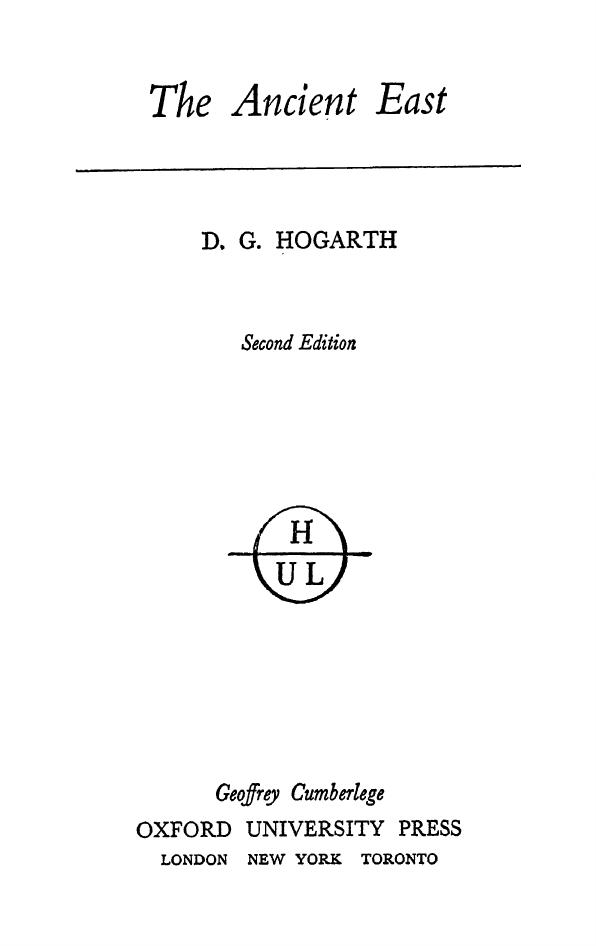The Ancient East by D. G. Hogarth

Author:D. G. Hogarth
Language: eng
Format: epub, pdf
Tags: ancient, history, eastern, babylonian, empire, babylonians, archaeology, ashmolean
ISBN: 9781781668061
Publisher: Andrews UK Limited 2012
Published: 2012-06-19T00:00:00+00:00
CHAPTER IV
THE EAST IN 400 B.C.
As the fifth century draws to its close the East lies revealed at last in the light of history written by Greeks. Among the peoples whose literary works are known to us, these were the first who showed curiosity about the world in which they lived and sufficient consciousness of the curiosity of others to record the results of inquiry. Before our present date the Greeks had inquired a good deal about the East, and not of Orientals alone. Their own public men, military and civil, their men of science, their men of letters, their merchants in unknown number, even soldiers of theirs in thousands, had gone up into Inner Asia and returned. Leading Athenians, Solon, Hippias and Themistocles, had been received at Eastern courts or had accompanied Eastern sovereigns to war, and one more famous even than these, Alcibiades, had lately lived with a Persian satrap. Greek physicians, Democedes of Croton, Apollonides of Cos, Ctesias of Cnidus, had ministered to kings and queens of Persia in their palaces. Herodotus of Halicarnassus had seen Babylon, perhaps, and certainly good part of Syria; Ctesias had dwelt at Susa and collected notes for a history of the Persian Empire; Xenophon of Attica had tramped from the Mediterranean to the Tigris and from the Tigris to the Black Sea, and with him had marched more than ten thousand Greeks. Not only have works by these three men of letters survived, wholly or in part, to our time, but also many notes on the East as it was before 400 B.C. have been preserved in excerpts, paraphrases and epitomes by later authors. And we still have some archaeological documents to fall back upon. If the cuneiform records of the Persian Empire are less abundant than those of the later Assyrian Kingdom, they nevertheless include such priceless historical inscriptions as that graven by Darius, son of Hystaspes, on the rock of Behistun. There are also hieroglyphic, hieratic and demotic texts of Persian Egypt; inscriptions of Semitic Syria and a few of archaic Greece; and much other miscellaneous archaeological material from various parts of the East, which, even if uninscribed, can inform us of local society and life.
SECTION 1. EASTWARD MOVEMENT OF THE GREEKS
The Greek had been pushing eastward for a long time. More than three hundred years ago, as has been shown in the last chapter, he had become a terror in the farthest Levant. Before another century had passed he found his way into Egypt also. Originally hired as mercenaries to support a native revolt against Assyria, the Greeks remained in the Nile valley not only to fight but to trade. The first introduction of them to the Saite Pharaoh, Psammetichus, was promoted by Gyges the Lydian to further his own ends, but the first development of their social influence in Egypt was due to the enterprise of Miletus in establishing a factory on the lowest course of the Canopic Nile. This post and two standing camps of Greek
Download
This site does not store any files on its server. We only index and link to content provided by other sites. Please contact the content providers to delete copyright contents if any and email us, we'll remove relevant links or contents immediately.
| Anthropology | Archaeology |
| Philosophy | Politics & Government |
| Social Sciences | Sociology |
| Women's Studies |
Mysteries by Colin Wilson(2889)
People of the Earth: An Introduction to World Prehistory by Dr. Brian Fagan & Nadia Durrani(2349)
Ancient Worlds by Michael Scott(2107)
Foreign Devils on the Silk Road: The Search for the Lost Treasures of Central Asia by Peter Hopkirk(2057)
The Memory Code by Lynne Kelly(1950)
Lost Technologies of Ancient Egypt by Christopher Dunn(1803)
The Splendid and the Vile by Erik Larson(1787)
Come, Tell Me How You Live by Mallowan Agatha Christie(1771)
The Earth Chronicles Handbook by Zecharia Sitchin(1750)
The Plantagenets by Dan Jones(1617)
Last Chance to See by Douglas Adams(1601)
The Return of the Gods by Erich von Daniken(1575)
Wars of the Anunnaki by Chris H. Hardy(1392)
Before the Dawn by Nicholas Wade(1317)
Keeper of Genesis by Graham Hancock(1280)
The Cygnus Mystery by Andrew Collins(1259)
The Message of the Sphinx by Graham Hancock(1226)
Fragile Lives by Stephen Westaby(1118)
Hieroglyphs: A Very Short Introduction by Penelope Wilson(1037)
